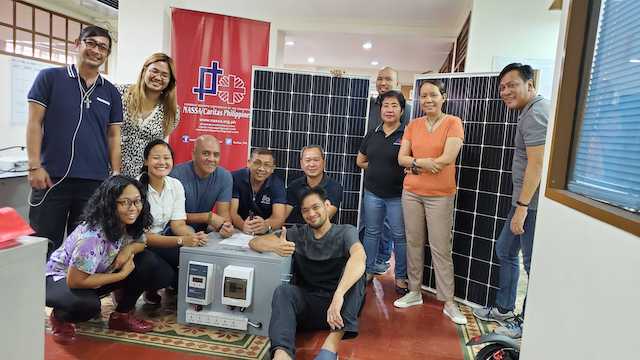

Time and again, it has been proven that whenever disasters happen in the Philippines, social infrastructure including electricity shuts down for days or months depending on the nature of the disaster and where it struck. In the absence of electricity, all human activity is severely disrupted; economic and business activities grind to a halt as systems are damaged or ruined.
Right now, Filipinos and the rest of the world are seeing the impact of the Taal Volcano's threat of explosion on the lives and livelihoods of thousands of citizens living and working within 60 kilometers of the volcano. According to reports, the ashfall knocked down power distribution circuits throughout Tagaytay City and parts of Batangas, Cavite, and Laguna. Volcanic fragments also caused outages in 5 major transmission facilities.
In the meantime, in the last two years, other calamities have occurred, including man-made disasters such as the war in Marawi. Welfare agencies have reported that many evacuation centers do not have sufficient electricity supplies to accommodate the needs of those who sought shelter. Schools and churches whose facilities have been converted into staging grounds for disaster relief efforts end up running electricity bills by the millions after just one month.
It is most frustrating to environment advocacy groups that despite the immediate availability of means to address this problem, local government units and even the national government and its agencies continue to fail to take action.
What’s the immediate solution? Solar energy and solar PV systems.
Solar PV systems can be customized and immediately deployed. Even without storage systems that can ensure 24-7 electricity supplies, a solar PV installation can generate electricity to power lights, electric fans, radios, and charge cellphones.
Solar PV power systems give out carbon emission-free electricity fueled by the sun; it’s energy that’s clean, safe, and free. When communities are slow to recover from a disaster, their overall economic health and social viability are threatened. Inevitably, more complex measures will become necessary to return affected communities to normal after they have been given relief in the in the early stages of disaster. During disasters, access to electricity means being able to operate electric fans, refrigerators, mosquito repelling lamps, water purifying systems. The uses and benefits of these are obvious and very important: these can stop health emergencies from erupting even as they can ensure a better level of comfort and safety for those in the evacuation centers.
While it is true that in the last decade the concept of “the resilient community” has become popular, sadly, in most cases, the urgent need for electricity access is hardly considered during preparations against disasters; it is only considered in the wake of disasters when supplies have been cut off.
We must work for disaster resilience in all our communities not only to restore the economic and social viability of the community following disasters, but to ensure that the negative experiences of those affected do not worsen. Resilience also means that electricity, water, and communication lines are not cut off. Utilizing and fully maximizing the uses of solar energy and solar PV systems can increase community resilience by providing homes and community institutions backup power even if the electricity from the grid is not restored. Local governments and national agencies should spearhead the installation of solar microgrids all over the country and develop community solar, which is a partnership between citizens, government, and businesses. (READ: Aeta lolas to install solar-powered lamps in villages)
At the height of relief efforts, community needs for temporary power can range from 100 watts to 100 kW. The most basic portable solar PV systems are built in 4 configurations: suitcase, trailer, container, and full array. Each type has different uses, and there is a specific type that’s suitable for different cases of disaster response and recovery efforts. They can be used to help restore communications for charging stations and power basic medical equipment. The systems with higher capacities can power small medical clinics and shelters as well as water pumps.
During disasters, time becomes the most critical factor and not cost or capacity. People need help and they need it as soon as possible, and sometimes they will need it for protracted periods depending on how efficient or inefficient government authorities are in restoring order. For short periods, gensets can be effective, but in cases when people are forced to stay for extended periods in evacuation centers and restoring the grid will take weeks or months, solar-run power systems are the best alternative. (READ: Home solar panels: A beginner's guide to saving electricity)
Recently, a renewable energy social enterprise donated to the Catholic Church’s advocacy arm NASSA-Caritas a DREAM Machine. “DREAM” stands for Disaster Recovery Emergency Assistance Machine. A compact solar PV installation, it weighs 80 kgs and can be immediately employed in areas of disasters to provide immediate electricity during daytime. It can power cellphones, handheld radios, digital cameras, as well as rechargeable lanterns, flashlights, and nebulizers. The entire system can be quickly and easily installed in disaster sites, and then uninstalled after use to be taken to another site or stored in preparation for the next disaster. It’s now on the way to Batangas to be used in the church’s relief efforts.
It’s important that companies engaged in solar power generation or storage should be tapped to become part of the disaster recovery initiatives. Given that the mining operations for diesel and other fossil fuels contribute to the natural calamities we continue to face, it really is time for the country to make the shift to renewal energy sources and to maximize solar energy disaster response and recovery efforts. – Rappler.com